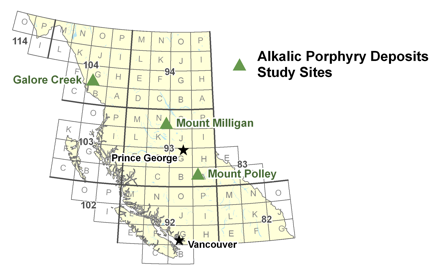Summary

Alkalic gold-(copper) deposits are of increasing economic significance and can be an attractive exploration target. They include some of the world's highest grade and largest porphyry-related gold resources (e.g., Ridgeway: 77 Mt @ 1.87 g/t Au, 0.63 % Cu -- 5.09 Moz Au; Galore Creek resource of 13.75 Moz Au, 156.4 Moz Ag, and 12.0 billion pounds Cu), as well as some of the largest gold accumulations in epithermal settings (Ladolam, ~48.6 Moz Au; Porgera, ~19.6 Moz; Cripple Creek, ~26.7 Moz; and Emperor ~9.5 Moz) (http://geopubs.wr.usgs.gov/open-file/of99-556/). Furthermore, alkalic porphyry Cu deposits contribute to the economy of British Columbia, and are driving significant new exploration in the province. The economic importance of the alkalic class of porphyry deposits to British Columbia is thus well established. However, exploration for them is difficult because of their small footprint and alteration assemblages that are different in significant details from those characteristic of porphyry Cu deposits associated with subalkalic igneous complexes. Hence, there is a need to better define the characteristics of the somewhat anomalous but potentially very metal-rich alkalic porphyry systems from the academic perspective of building a holistic model but also from a practical perspective of providing simple tools for exploration in British Columbia.
This multi-disciplinary research project will advance the understanding of the characteristics of individual alkalic porphyry systems and integrate that information into a holistic model for the deposit class. The project will address fundamental questions regarding deposit genesis that will provide practical criteria useful for exploration. The proposed project is part of a larger project investigating epithermal and porphyry environments associated with alkalic rocks.